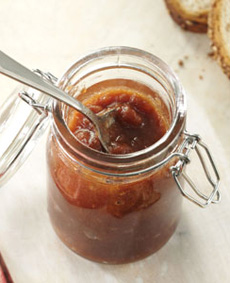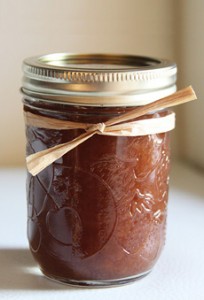TIP OF THE DAY: 25+ Uses For Apple Butter
|
We were recently searching for something in the back of a friend’s pantry—at her request—and came across a jar of apple butter that looked past its prime. We checked the date. Yep, way gone.
“Do you know you have expired apple butter?” we queried. “Oh that,” she replied. “Someone gave it to me years ago and I didn’t know what to do with it.” Apple butter is not butter, we explained. It’s a fruit spread so creamy, it spreads like butter. There’s no dairy in it. Think of it as creamy apple jam. Today’s tip is for anyone who needs suggestions for using apple butter, and for those who want to make their own from the fall crop of just-picked apples. There’s a slow cooker recipe below. WHAT IS APPLE BUTTER? Apple butter is a highly concentrated form of apple sauce, as dense as a spread. While the skins are used, since the apples are cooked to a point where the sugar in the flesh caramelizes and the flesh turns brown, the color of the apple doesn’t make a difference. |
 Ready, set spread your delicious homemade apple butter. Photo courtesy TasteOfHome.com. |
|
|
THE HISTORY OF APPLE BUTTER In the Middle Ages, the first monasteries with large fruit orchards began to appear in Europe. Apple butter, developed at that time, turned out to have a long shelf life (due to the concentration of sugars). It was an ideal way to conserve part of the apple crop. Villagers made their own apple butter, and a popular bread spread was born. As imported spices became more affordable, apple butter was enhanced with allspice, cinnamon, clove and nutmeg. Fast forward some centuries to the colonization of North America: Housewives brought the technique for making apple butter with them. In the 1700s, the German Rhinelanders and Moravians who settled into the Blue Ridge Mountains, especially in Kentucky, North Carolina, Tennessee and West Virginia, “really honed apple butter-making to a deliciously fine art.” (Source: FoodTimeline.org.) In the 1800s, another German immigrant group, the Pennsylvania Dutch (a misspelling of Deutsch), established the tradition in southeastern Pennsylvania. In the latter half of the century, with the invention of the Mason jar, apple butter was “put up” by even more households. These days, you can freeze it. Apple butter’s popularity declined in the 20th century, with the proliferation of store-bought brands of jam and jelly providing a wide variety of fruit options year-round. You can use any apples, but soft apples work best because they cook down the fastest. Choose one (or more) of these varieties, and you’ll have apple butter in no time: Breakfast |
||
 All you need to turn apple butter into a homemade gift is a ribbon! Photo courtesy EspressoandCream.com. |
Dinner |
|
|
Snack Because the apples cook for a long period, this is a recipe best made in a slow cooker. Plan to start cooking early in the morning. For gifting, use 8-ounce Mason or Ball jars, or other attractive jars. Note that the apple butter won’t have any preservatives, so should be refrigerated or frozen. This recipe is courtesy Taste Of Home. 1. PLACE the apples in a 3-quart slow cooker. Combine the other ingredients, pour over the apples and mix well. Cover and cook on high for 1 hour. 2. REDUCE the heat to low; cover and cook for 9-11 hours or until thickened and dark brown, stirring occasionally. Stir more frequently as the spread thickens, to prevent sticking. 3. UNCOVER and cook on low 1 hour longer. If desired, stir with a wire whisk until smooth. 4. SPOON into jars or freezer containers, leaving a half inch of space at the top. Cover and refrigerate or freeze. †You can use apple butter like applesauce, as a replacement for oil, eggs and butter, in most baked good recipes. Like applesauce, it provides sweetness and moistness in breads, cakes, cookies, muffins, pancakes and waffles. Look for tested recipes. ‡You can cut back on the sweetness, or try one batch and then adjust it.
|
||


